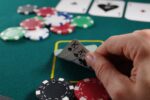How to Play Bingo with Playing Cards – A Fun Twist on a Classic Game
Bingo has long been a favourite pastime for people of all ages, providing hours of excitement and anticipation. Traditionally played with numbered balls or tokens, bingo has evolved over time, leading to various creative adaptations. One such variation is playing bingo with standard playing cards, which adds an exciting twist to the classic game. Here are two versions of bingo with playing cards, each a little bit different. In one variation, players will add up their card values to determine a win. In the other variation, players will simply match cards with dealer.
Both of these versions of Bingo have a ‘pot.’
Putting chips into a pot to help determine the winner can be a lot of fun. While it’s not really needed (you can always keep score with a pencil and paper), the pot can add a fun dimension to the game. When I was a child, my father loved to have wild games of family poker, and we’d use plastic poker chips for the ‘pot.’ So keep a box of poker chips in the camper for those rainy day games. But if you don’t have chips, any small items will work: toothpicks, pennies, pony beads, monopoly houses or other game pieces, dried beans, or macaroni. Or you can always cut a piece of cardboard (cereal box for example) into many tiny squares. If you don’t want to use chips, you can keep score on paper.
Bingo with Blackjack Rankings
Our first version of bingo with playing cards requires two standard decks and uses card values similar to blackjack.
Setup:
- Gather two standard 52-card decks without jokers.
- Choose two or more players and ensure everyone has an even number of cards (e.g., five cards each).
- Place the same number of cards as each player face-down in the center of the table – these are the Common Cards. Note: I think it would be an easier game for younger players if the dealer used twice as many cards as the players.
Gameplay:
- Assign values to the cards:
- Face cards: 10 points
- 10 through 2: Their face value
- Aces: One or eleven, according to the player’s needs
- Ante into the pot: Before the game begins, each player contributes to the pot.
- The dealer turns over the first Common Card: The dealer reveals the first card from the deck, and any matching cards in a player’s hand are removed from the hand and placed on the table in front of them.
- Continue revealing common cards: The dealer goes on turning over each common card one by one until all are revealed.
- Determine the winners by adding your score:The player with the highest score and the player with the lowest score split the pot at the end of the hand.
Add up scores by counting cards that matched the dealer. So for example, if a player’s hand contains 5, 9, Q, Q, J, and the dealer revealed 5, 9, Q, 2, K as common cards, the player’s total score for that round is 5+9+10+10=34.
Tip: If you know you’re not going to be the highest hand, you might want to try to be the lowest hand by counting your Ace as a 1 and not an 11.
- Bingo call:If a player manages to match all their cards, they call “Bingo!” and win the entire pot. A new round then begins.
Bingo with a Prize Pool
Our second version of bingo uses a single deck of playing cards and is an easier-to-play variant, perfect for players who prefer a quicker and more straightforward game, or for younger players. Word of warning, however – this variation might require a lot of poker chips!
Setup:
- Prepare one standard 52-card deck without jokers.
- Determine the ante for each player, and make sure everyone is ready to play. Note: the ‘ante’ is the amount each player will put into the ‘pot’ at the start of the game. Because this game requires more pot contributions throughout the game, best to start with a low ante.
Gameplay:
- Deal the cards: The dealer deals five cards face-down to each player and places the rest of the deck face-down in the center of the table.
- Turn over the common cards: The dealer reveals the top card from the stack one at a time, and calls each one out.
- Discard matching cards: Players holding cards of the same rank as the revealed common card remove the cards from their hand and place them in on the table in front of them.
- Pay for un-called cards: If a player’s cards were not called during a round, they must pay an amount equal to the ante for each remaining card in their hand.
- Continue playing rounds: Repeat steps 1 to 4 until a player calls “Bingo!” by matching all five cards from their hand.
- Bingo call and prize: The player who calls “Bingo!” wins the pot uncontested. In the case of a tie, the players who called “Bingo!” split the pot.
We hope you have fun with these games! They are easy and playing with little more than a deck of cards and pencil and paper. Games like this are always more fun with a large crowd, so next time you’re hanging out around a campfire, at the pub, or even in your own living room with friends, pull out that deck of cards and have fun playing BINGO!





